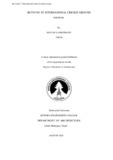Please use this identifier to cite or link to this item:
https://elibrary.khec.edu.np:8080/handle/123456789/621Full metadata record
| DC Field | Value | Language |
|---|---|---|
| dc.contributor.advisor | Ar. Sakar Shrestha | - |
| dc.contributor.author | BIGYAN LAMICHHANE 740109 | - |
| dc.date.accessioned | 2023-09-13T09:38:15Z | - |
| dc.date.available | 2023-09-13T09:38:15Z | - |
| dc.date.issued | 2023-08 | - |
| dc.identifier.uri | https://elibrary.khec.edu.np/handle/123456789/621 | - |
| dc.description.abstract | The architectural thesis report explores the concept of reviving a cricket stadium, focusing on the adaptive reuse and transformation of an existing facility. The project aims to revitalize a historic cricket stadium that has fallen into disuse and neglect, restoring it as a vibrant sporting and cultural hub within the community. The report investigates the architectural design strategies employed to enhance the stadium's functionality, sustainability, and spectator experience while preserving its historical significance. Through a comprehensive analysis of the site and an examination of the stadium's historical context, the report identifies the challenges faced in its revival and proposes innovative design solutions. The research includes an exploration of modern cricket stadium design trends, sustainable principles, and the integration of smart technologies to elevate the stadium's performance and user satisfaction. The thesis report presents a detailed architectural design proposal that incorporates key elements such as upgraded seating arrangements, improved sightlines, accessibility enhancements, and advanced audio-visual systems. The design also addresses infrastructure requirements, including player facilities, media areas, and hospitality amenities, to meet international standards and accommodate a wide range of events beyond cricket matches. Furthermore, the report highlights the integration of sustainable design principles, encompassing energy-efficient systems, rainwater harvesting, and waste management strategies. The incorporation of green spaces, landscaping, and public amenities contributes to creating a holistic and inviting environment that encourages community engagement and recreational activities. The thesis project emphasizes the significance of preserving the stadium's heritage value while adapting it to modern requirements. This involves meticulous restoration of architectural features, materials, and finishes, while integrating contemporary elements that enhance functionality and aesthetics. In conclusion, the architectural thesis report on reviving a cricket stadium presents a comprehensive design approach that breathes new life into a forgotten sporting venue. By blending history, innovation, and sustainability, the proposed design aims to reestablish the stadium as a vital cultural and sporting landmark, promoting community participation, fostering a sense of pride, and contributing to the overall urban fabric. | en_US |
| dc.title | REVIVING TU INTERNATIONAL CRICKET GROUND Kirtipur | en_US |
| local.college.name | Khwopa Engineering College | - |
| local.degree.department | Department of Architecture | - |
| local.degree.name | BE Architecture | - |
| local.degree.level | Bachelor's Degree | - |
| local.item.accessionnumber | D.1325 | - |
| Appears in Collections: | Architecture 2074 Batch Thesis | |
Files in This Item:
| File | Description | Size | Format | |
|---|---|---|---|---|
| 740109_Bigyan.pdf Restricted Access | 27.53 MB | Adobe PDF |  View/Open Request a copy |
Items in DSpace are protected by copyright, with all rights reserved, unless otherwise indicated.
